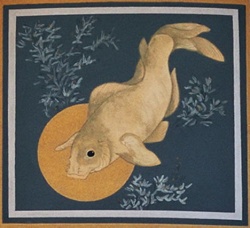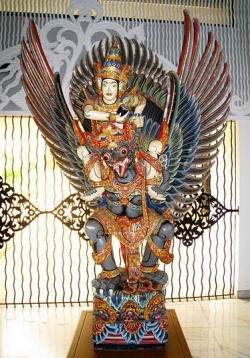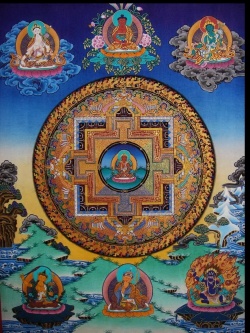Hindu cosmology
In Hindu cosmology the universe is, according to Hindu tradition and Vedic cosmology, cyclically created and destroyed.
Description
The Hindu cosmology and timeline is the closest to modern scientific timelines and even more which might indicate that the Big Bang is not the beginning of everything but just the start of the present cycle preceded by an infinite number of universes and to be followed by another infinite number of universes. It also includes an infinite number of universes at one given time.
The Rig Veda questions the origin of the cosmos in: "Neither being (sat) nor non-being was as yet. What was concealed? And where? And in whose protection?…Who really knows? Who can declare it? Whence was it born, and whence came this creation? The devas were born later than this world's creation, so who knows from where it came into existence? None can know from where creation has arisen, and whether he has or has not produced it. He who surveys it in the highest heavens, he alone knows-or perhaps does not know." (Rig Veda 10. 129)
The Rig Veda's view of the cosmos also sees one true divine principle self-projecting as the divine word, Vaak, 'birthing' the cosmos that we know, from the monistic Hiranyagarbha or Golden Womb. The Hiranyagarbha is alternatively viewed as Brahma, the creator who was in turn created by God, or as God (Brahman) himself. The universe is considered to constantly expand since creation and disappear into a thin haze after billions of years. An alternate view is that the universe begins to contract after reaching its maximum expansion limits until it disappears into a fraction of a millimeter. The creation begins anew after billions of years (Solar years) of non-existence.
The puranic view asserts that the universe is created, destroyed, and re-created in an eternally repetitive series of cycles. In Hindu cosmology, a universe endures for about 4,320,000,000 years (one day of Brahma, the creator or kalpa) and is then destroyed by fire or water elements. At this point, Brahma rests for one night, just as long as the day. This process, named pralaya (literally especial dissolution in Sanskrit, commonly translated as Cataclysm), repeats for 100 Brahma years (311 Trillion, 40 Billion Human Years) that represents Brahma's lifespan. Brahma is regarded as a manifestation of Brahman as the creator.
We are currently believed to be in the 51st year of the present Brahma and so about 156 trillion years have elapsed since He was born as Brahma. After Brahma's "death", it is necessary that another 100 Brahma years (311 Trillion, 40 Billion Years) pass until a new Brahma is born and the whole creation begins anew. This process is repeated again and again, forever.
Brahma's day is divided in one thousand cycles (Maha Yuga, or the Great Year). Maha Yuga, during which life, including the human race appears and then disappears, has 71 divisions, each made of 14 Manvantara (1000) years. Each Maha Yuga lasts for 4,320,000 years. Manvantara is Manu's cycle, the one who gives birth and governs the human race. before & after each manvantara there's a sandhikal as long as krutyuga & in that time there is all water on earth. Each Maha Yuga consists of a series of four shorter yugas, or ages. The yugas get progressively worse from a moral point of view as one proceeds from one yuga to another. As a result, each yuga is of shorter duration than the age that preceded it. The current Kali Yuga (Iron Age) began at midnight 17 February / 18 February in 3102 BC in the proleptic Julian calendar (Year 6898 of the Holocene Era.) kalpa=ahoratra of brahma. Space and time are considered to be maya (illusion). What looks like 100 years in the cosmos of Brahma could be thousands of years in other worlds, millions of years in some other worlds and 311 trillion and 40 billion years for our solar system and earth. The life span of Lord Brahma, the creator, is 100 'Brahma-Years'. One day in the life of Brahma is called a Kalpa or 4.32 billion years. Every Kalpa creates 14 Manus one after the other, who in turn manifest and regulate this world. Thus, there are fourteen generations of Manu in each Kalpa. Each Manu's life (Manvantara) consists of 71 Chaturyugas (quartets of Yugas or eras). Each Chaturyuga is composed of four eras or Yugas: Satya, Treta, Dwapara and Kali. if we add all manvantaras(4320000x71x14)as long as 4 chaturyuga will be missing its because sandhikaal.after & before each manvantara so 15 sandhikaal The span of the Satya Yuga is 1,728,000 human years, Treta Yuga is 1,296,000 human years long, the Dwapara Yuga 864,000 human years and the Kali Yuga 432,000 human years. When Manu perishes at the end of his life, Brahma creates the next Manu and the cycle continues until all fourteen Manus and the Universe perish by the end of Bramha's day. When 'night' falls, Brahma goes to sleep for a period of 4.32 billion years, which is a period of time equal one day (of Brahma) and the lives of fourteen Manus. The next 'morning', Brahma creates fourteen additional Manus in sequence just as he has done on the previous 'day'. The cycle goes on for 100 'divine years' at the end of which Brahma perishes and is regenerated. Bramha's entire life equals 311 trillion, 40 billion years. Once Bramha dies there is an equal period of unmanifestation for 311 trillion, 40 billion years, until the next Bramha is created.
The present period is the Kali Yuga or last era in one of the 71 Chaturyugis (set of four Yugas/eras) in the life one of the fourteen Manus. The current Manu is said to be the seventh Manu and his name is Vaivasvat.
According to Aryabhata, the Kali Yuga began in 3102 BC, at the end of the Dvapara Yuga that was marked by the disappearance of Vishnu's Krishna avatar. Aryabhata's date is widely repeated in modern Hinduism.
The beginning of the new Yuga (era) is known as "Yugadi/Ugadi", and is celebrated every year on the first day (Paadyami) of the first month (Chaitramu) of the 12-month annual cycle. But this is a disambiguation for beginning of new year in lunisolar calendar followed by most Hindus. The Ugadi of 1999 begins the year 1921 of the Shalivahana era (5101 Kali Yuga, 1999 AD). The end of the Kali Yuga is 426,899 years from 1921.
Overview of Yugas:
Satya Yuga (Krita Yuga):- 1,728,000 Human years
Treta Yuga:- 1,296,000 Human years
Dwapara Yuga:- 864,000 Human years
Kali Yuga:- 432,000 Human years (5,111 years have passed; 426,889 years remain). Kaliyuga started in 3102 B.C.; CE 2009 corresponds to Kaliyuga year 5,111
Further elaborations from the Vedic texts
Rig Veda
The Nasadiya Sukta of the Rig Veda describes the origin of the universe. The Rig Veda's view of the cosmos also sees one true divine principle self-projecting as the divine word, Vaak, 'birthing' the cosmos that we know, from the monistic Hiranyagarbha or Golden Egg. The Hiranyagarbha is alternatively viewed as Brahma, the creator who was in turn created by God, or as God (Brahman) Himself. The Universe is preserved by Vishnu (The God of Preservation) and destroyed by Shiva (The God of Destruction). These three constitute the holy trinity (Trimurti) of the Hindu religion. Once the Universe has been destroyed by Shiva, Brahma starts the creation once again. This creation-destruction cycle repeats itself almost endlessly as described in the section above on Brahma, Manu and the Yugas.
The Puranas
The later Puranic view asserts that the Universe is created, destroyed, and re-created in an eternally repetitive series of cycles. In Hindu cosmology, a universe endures for about 4,320,000,000 years—one day/Kalpa of Brahma, the creator, and is then destroyed by fire or water elements. At this point, Brahma rests for one night, just as long as the day. This process, named Pralaya (Cataclysm), repeats for 100 Brahma years (311 trillion, 40 billion human years) that represents Brahma's lifespan. Brahma is the creator but not necessarily regarded as God in Hinduism because there are said to be many creations. Instead, he is regarded as a creation of the Supreme God or Brahman.
We are currently believed to be in the 51st year of the present Brahma's life and so about 158.7 trillion years have elapsed since the birth of Brahma. After Brahma's "death", it is necessary that another 100 Brahma years pass until he is reborn and the whole creation begins anew. This process is repeated again and again, forever.
Brahma's day is divided in one thousand cycles (Maha Yuga, or the Great Year). Maha Yuga, during which life, including the human race appears and then disappears, made of 14 Manvantarahas each has 71 divisions. Each Maha Yuga lasts for 4,320,000 years. Manvantara is Manu's cycle, the one who gives birth and governs the human race.
Each Maha Yuga consists of a series of four shorter yugas, or ages as described earlier. The degree of happiness, prosperity and righteousness progressively decays as one proceeds from one yuga to another. Each yuga is of shorter duration than the age that preceded it. The current Kali Yuga (Iron Age) began at midnight 17 February / 18 February in 3102 BC in the proleptic Julian calendar. (Year 6898 of the Holocene Era.)
Only some Puranas describe a universe that is cyclical or oscillating and infinite in time. The universe is described as a cosmic egg that cycles between expansion and total collapse. It expanded from a concentrated form — a point called a Bindu. The universe, as a living entity, is bound to the perpetual cycle of birth, death, and rebirth.
The Padma Purana discusses the number of different types of life-forms in the universe. According to the Padma Purana, there are 8,400,000 life-form species, 900,000 of which are aquatic ones; 2,000,000 are trees and plants; 1,100,000 are small living species, insects and reptiles; 1,000,000 are birds; 3,000,000 are beasts and 400,000 are human species.
Multiverse in Hinduism
The concept of multiverses is mentioned many times in Hindu Puranic literature, such as in the Bhagavata Purana:
Every universe is covered by seven layers — earth, water, fire, air, sky, the total energy and false ego — each ten times greater than the previous one. There are innumerable universes besides this one, and although they are unlimitedly large, they move about like atoms in You. Therefore You are called unlimited (Bhagavata Purana 6.16.37)
Lord Śiva said: "My dear son, I, Lord Brahmā and the other devas, who move within this universe under the misconception of our greatness, cannot exhibit any power to compete with the Supreme Personality of Godhead, for innumerable universes and their inhabitants come into existence and are annihilated by the simple direction of the Lord" (Bhagavata Purana 9.4.56)
After separating the different universes, the gigantic universal form of the Lord, which came out of the causal ocean, the place of appearance for the first puruṣa-avatāra, entered into each of the separate universes, desiring to lie on the created transcendental water (Bhagavata Purana 2.10.10)
The number of universes seems to be uncountable, immeasurable, or incalculable according to the Puranic literature:
Even though over a period of time I might count all the atoms of the universe, I could not count all of My opulences which I manifest within innumerable universes (Bhagavata Purana 11.16.39)
Analogies to describe multiple universes also exist in the Puranic literature:
What am I, a small creature measuring seven spans of my own hand? I am enclosed in a potlike universe composed of material nature, the total material energy, false ego, ether, air, water and earth. And what is Your glory? Unlimited universes pass through the pores of Your body just as particles of dust pass through the openings of a screened window (Bhagavata Purana 10.14.11)
Because You are unlimited, neither the lords of heaven nor even You Yourself can ever reach the end of Your glories. The countless universes, each enveloped in its shell, are compelled by the wheel of time to wander within You, like particles of dust blowing about in the sky. The śrutis, following their method of eliminating everything separate from the Supreme, become successful by revealing You as their final conclusion (Bhagavata Purana 10.87.41)
The layers or elements covering the universes are each ten times thicker than the one before, and all the universes clustered together appear like atoms in a huge combination (Bhagavata Purana 3.11.41)






